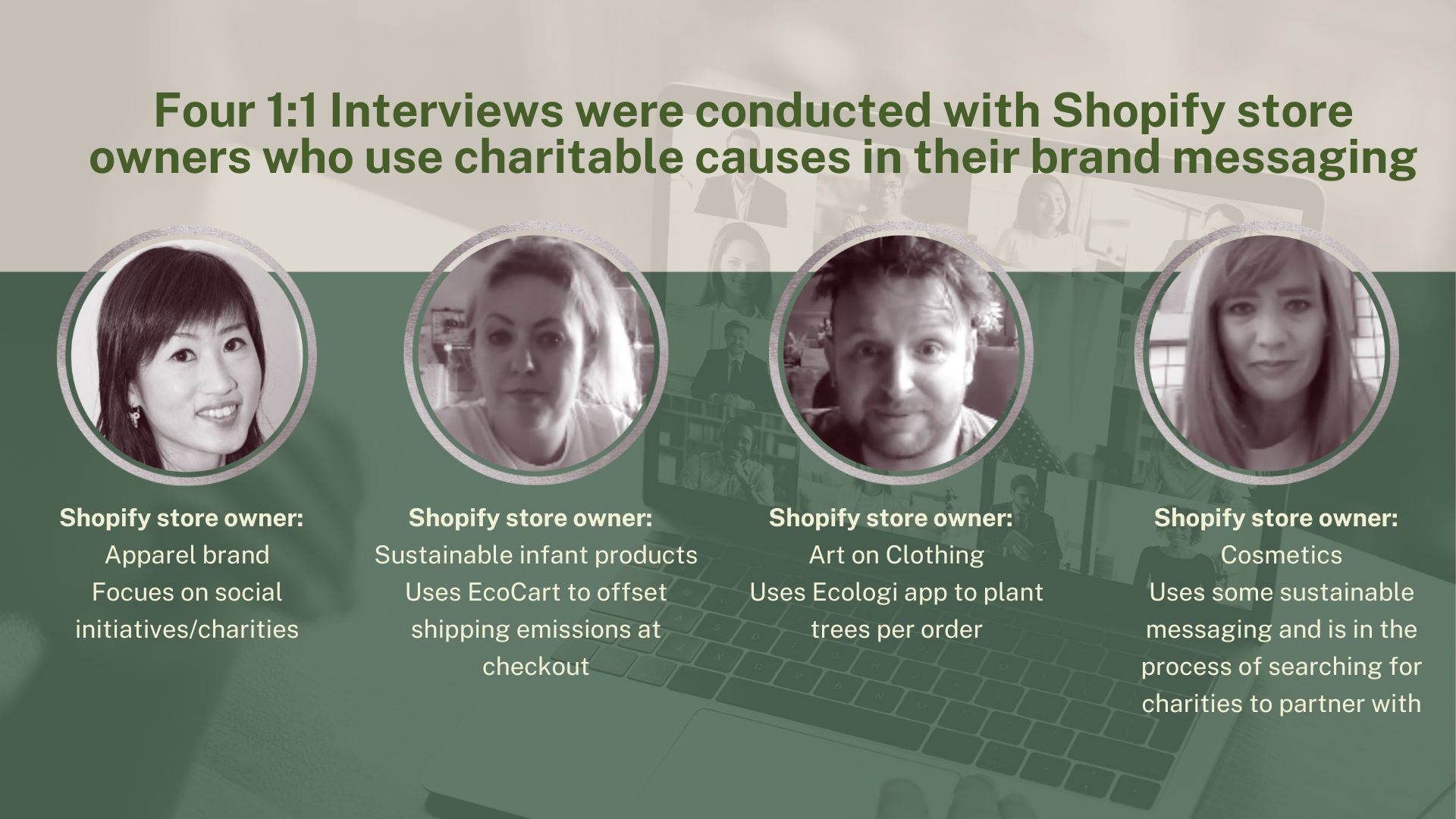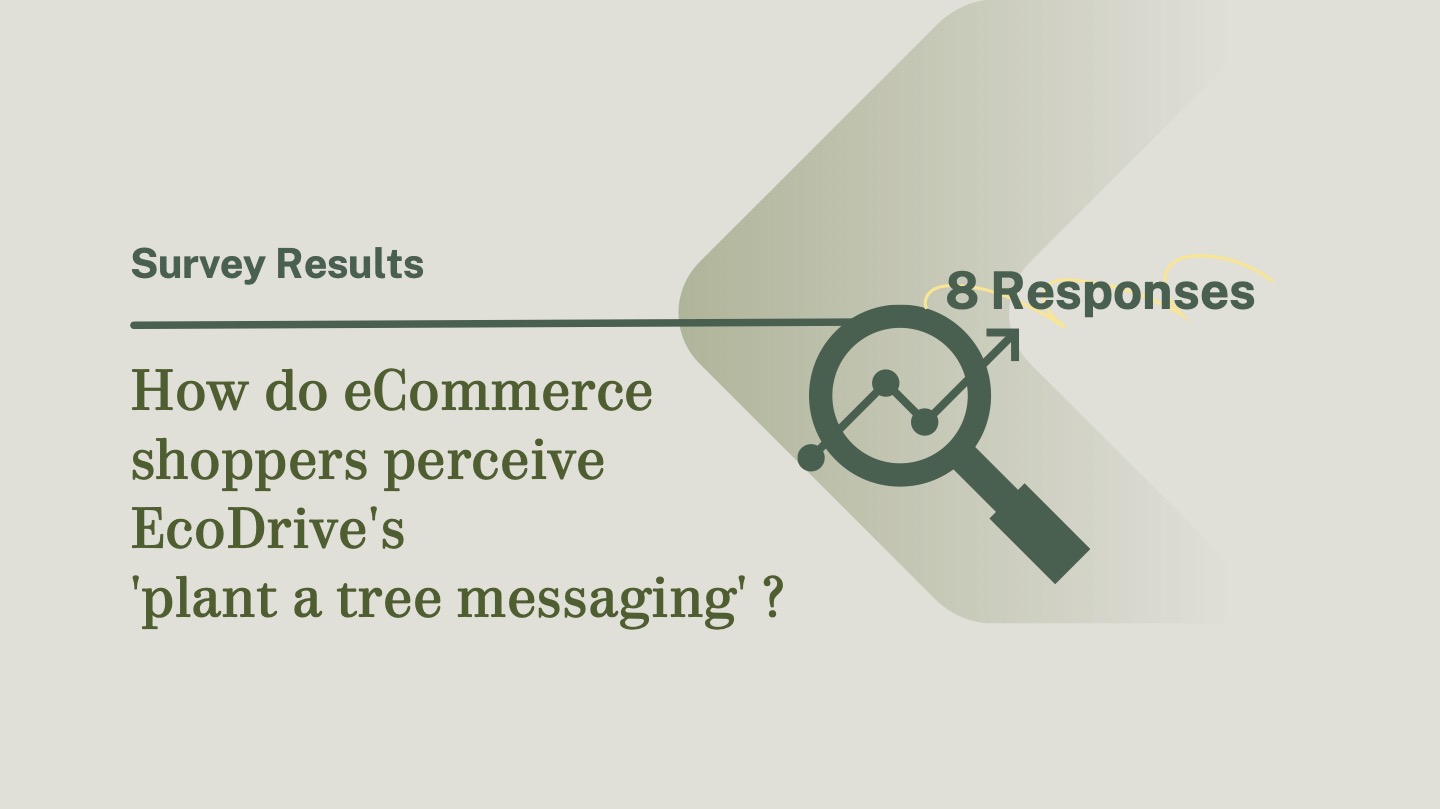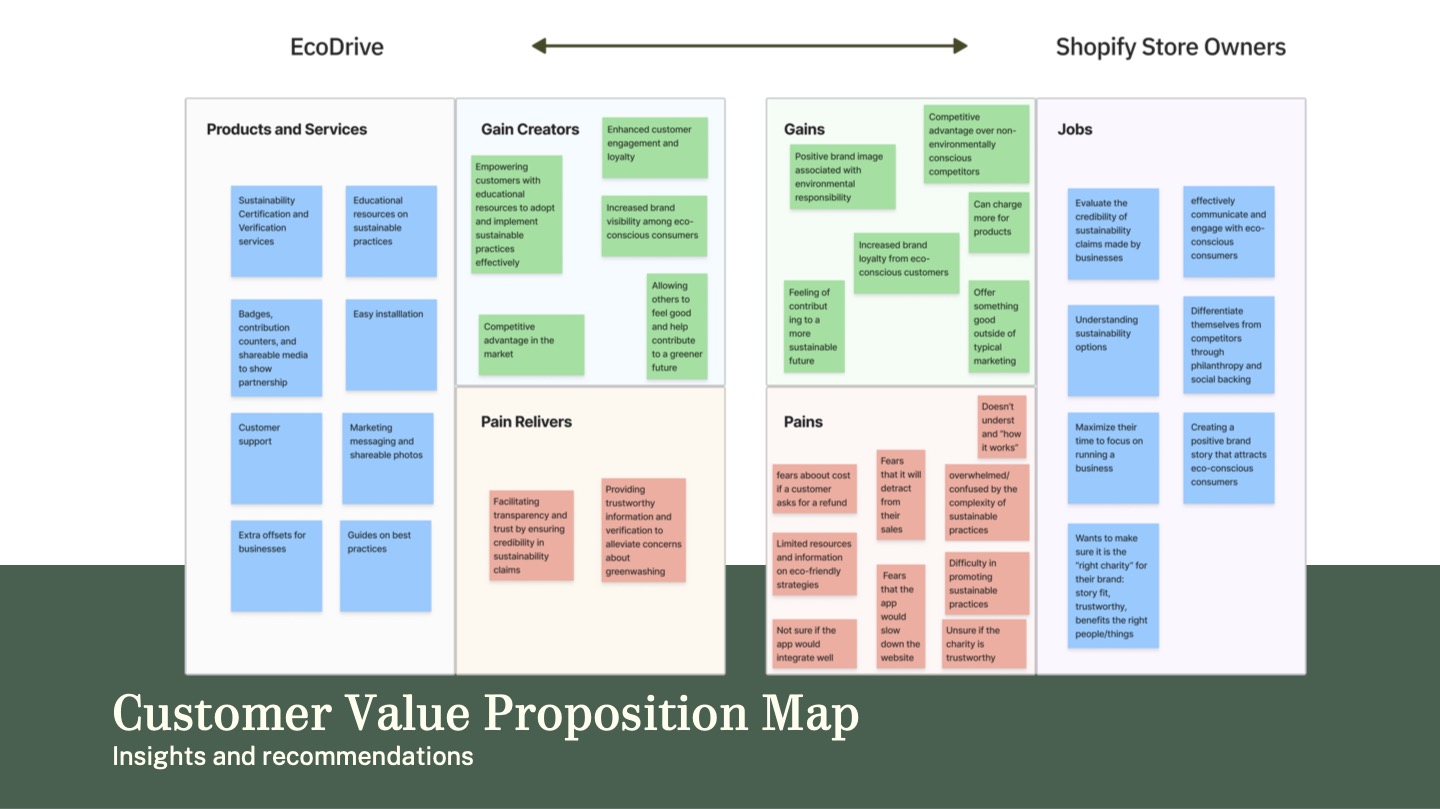Case Study:
EcoDrive
UX Research on EcoDrive’s “plant a tree” model in the Ecommerce space

Role:
UX Research
Tools:
Slack
Miro
Zoom
Duration:
June-July 2023

Overview
In this UX research case study, I explored EcoDrive’s innovative approach to sustainability in e-commerce. EcoDrive, a leader in verified, nature-based solutions, simplifies climate action for brands, enhancing their engagement with eco-conscious practices. In my role, I conducted extensive research to understand EcoDrive’s target audience. Over a seven-week period, I gathered insights and formulated recommendations, culminating in a comprehensive presentation of my findings to the Co-founder of EcoDrive, Blake Ruschman.
Research Goals
My main objectives were to learn from the target audience about their motivations and needs so that we can see where Ecodrive can improve on business value, effective messaging, and to see how consumers perceive other sustainability initiatives compared to “plant a tree”

Business Value
How can we gain a deeper understanding of the motivations and needs of eCommerce Shopify store owners to effectively communicate and demonstrate Ecodrive’s value?

Effective Messaging
How can we optimize Ecodrive’s messaging strategy to effectively communicate Ecodrive’s offerings to eCommerce shoppers and enhance consumer engagement?

Perception Comparison
How is the “plant a tree” model perceived by consumers compared to other sustainability initiatives?
Research Methods
There were two main audiences I focued on for the research project: Shopify eCommerce store owners and eCommerce Consumers.
I performed competitive research and conducted interviews to learn from the primary target audience; Shopify eCommerce Store Owners.
I used surveys to gain insights from the secondary target audience: eCommerce consumers

Primary Target Audience
Shopify eCommerce store owners

Secondary Target Audience
eCommerce Consumers


Competitive research:
In order to get a idea of the current market, I conducted competitive research where I compared user reviews between EcoDrive, Ecologi, One Tree Planted, Sprout, and EcoCart
I documented positives and negative findings from all 5 of these apps into a chart which you can reference by clicking on the following research report:
SWOT Analysis
In my research for EcoDrive, I compared user reviews from five different apps and developed a SWOT analysis.
EcoDrive’s strengths include its simplicity, additional services like offsets for businesses, easy installation, effective marketing messaging, strong customer support, and transparency. However, it faces weaknesses such as limited awareness due to under-communication of its full range of features, and a modest online presence with few and outdated reviews. Opportunities lie in offering multi-currency and language support to expand customer reach, and customizable marketing options, as appreciated in competitor reviews. A significant threat for EcoDrive is the growing competition in the eco-friendly space, necessitating a clear differentiation and effective communication of its unique value proposition to stand out.

Interviews
To gain a better understanding of the needs and motivations behind our primary target audience, I conducted four 1:1 interviews with Shopify store owners who use charitable causes in their brand messaging. I will go over a few of the common themes that they mentioned.

In my interviews with Shopify store owners for the EcoDrive case study, three key themes emerged.
Firstly, luxury pricing: interviewees, like Karen, noted their ability to charge higher prices due to their charitable initiatives, which also positively impacted their revenue. Secondly, app integrations: many expressed concerns about adding new apps, fearing website slowdowns and negative SEO impacts, as highlighted by Lindsey’s cautious approach towards app downloads. Lastly, market-driven philanthropy: the decision to adopt charitable causes was primarily influenced by market competitiveness rather than personal beliefs, with Lindsey emphasizing the necessity of a mission to stand out in the market.



Surveys
The next step in my research was to understand the motivations and perceptions behind eCommerce Consumers in regards to charitable initiatives

Survey 1:
We started off with one big survey as a cohort to see how eCommerce shoppers perceive charitable initiatives.
We took the responses people made and discovered that their motivations to support charitable initiatives fall into three categories: Trust, Understanding, and Value

Because of that finding I decided to take those themes and conduct another survey. This one focused on “how do eCommerce shoppers perceive EcoDrive’s ‘plant a tree messaging?” I conducted these in person with friends and family so that I could ask follow up questions for further understanding.

Using a likert scale of 1 being the least to 5 being the most, surveyors ranked how much they trusted, understood and valued each of the following banners.
The “1 Tree Planted Per Order” banner scored the highest in all three categories of Trust, Understand, and Value
“All of our orders are climate positive” scored the least in Trust and understanding. Survey participants commented that the messaging was not specific enough.

I tested Ecodrive’s messaging against 3 other competitor’s checkout banners to see what we could learn. Participants in the survey were asked “Which option would you most likely pick if you had to choose?”
0 out of 8 selected Ecodrives:
– Several participants mentioned that they didn’t choose option one because they didn’t understand the second sentence and what Ecodrive is.
– Several participants also mentioned that the fractional numbers were throwing them off so that is why they didn’t pick option 1 or 3
Participants that chose option 2 said that they chose it because they felt it was more of a value for their one purchase.
– A participant who chose option 3 said it is because he felt that choose that option was more related to my specific order
– Participants that chose option 4, mentioned that the clear and simple text felt more trustworthy.

I also used the survey to gain insights to how people perceive tree planting vs. carbon offsetting, vs. carbon credits.
7 out of 8 respondents would choose tree planting instead of carbon credits or carbon offsetting

Customer Value Proposition Map:
The customer Value Proposition map is a framework to help ensure a product or service is positioned around what the customer values and needs. I created the map using qualitative data from the user interviews to compare with the offerings from EcoDrive.
Key Insights:
- Overall EcoDrive is positioned very well around the customer values and needs. EcoDrive’s products/services, gain creators, and pain relievers match up very well with the customer.
- EcoDrive can improve on marketing itself enough across it’s channels such as the website, app store, and social media.

Recommendations
Business Value:
Ecodrive already meets the needs and provides great value to the target audience. But marketing and increased Awareness of what ecodrive offers to potential partners can be improved For example; to alleviate fears about product fit or integrations, ecodrive can offer free demos of the partnership backend. More reviews and video content on the website and app store product page can help increase more awareness of what ecodrive offers
Effective messaging:
Clear and straightforward messaging options perform better. Such as Ecodrives “1 tree planted for every order” vs. “offset CO2 with Ecodrive for $0.65 cents. More A/B testing is recommended
Perception comparison:
Based on the surveys conducted, “plant a tree” model is perceived more favorably by consumers than carbon offsetting or carbon credits. More consumer research is recommended for further validation
Conclusion
My research culminated in a set of actionable recommendations for EcoDrive, focused on enhancing user experience and broadening market appeal. By addressing key areas like simplified messaging, improved app integration, and market-driven philanthropy, I laid down a roadmap for EcoDrive to not only boost its online presence but also to fortify its position as a leader in sustainable solutions. The feedback from stakeholders was immensely positive, affirming the relevance and potential impact of our proposals.
Personal Learnings:
On a personal level, this project was a journey of growth. It honed my skills in UX research, especially in synthesizing diverse user feedback into coherent strategies. The challenge of balancing user needs with business objectives was a stimulating puzzle that pushed me to think creatively and empathetically. Most importantly, it reinforced my belief in the power of user-centered design in driving meaningful change.
Nadine Allan
Feel free to reach out!
